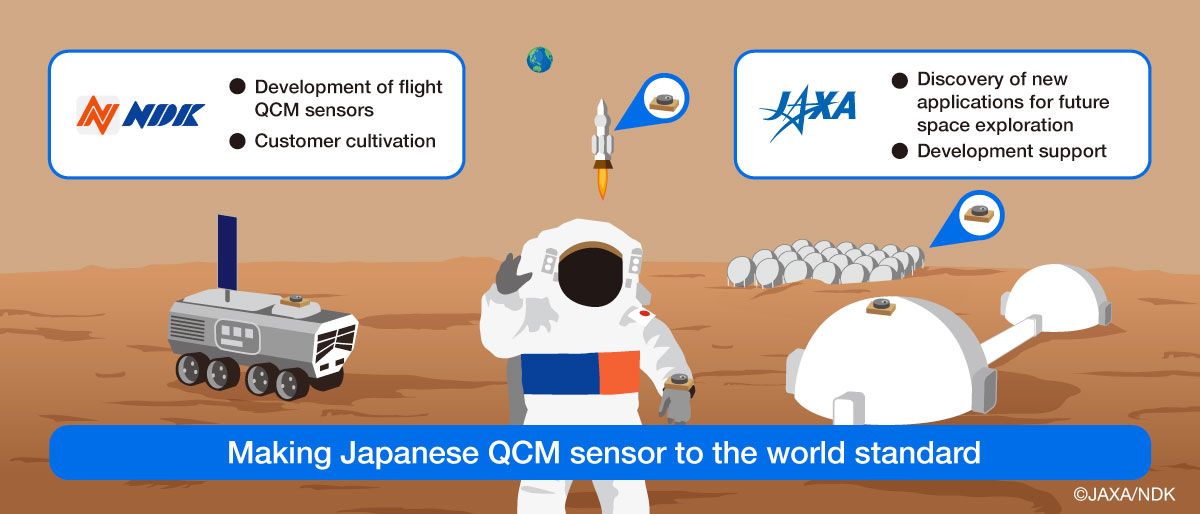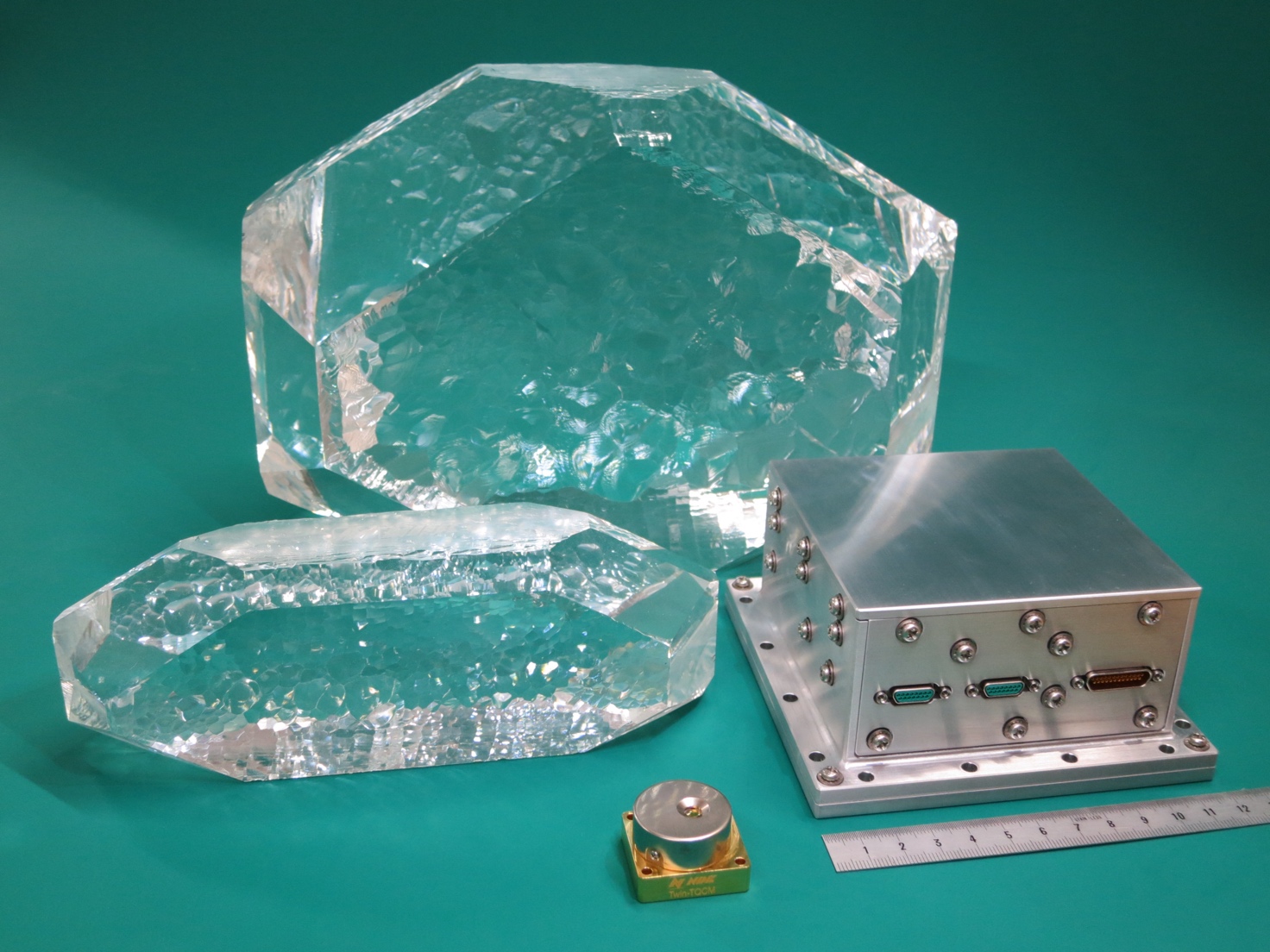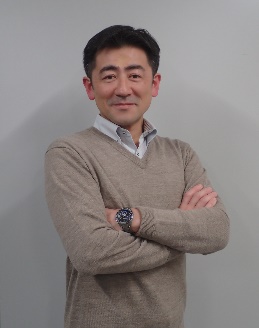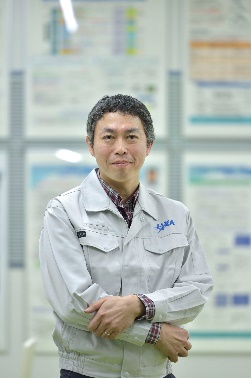Nihon Dempa Kogyo Co., Ltd. (NDK) and JAXA have Started co-creation activities related to "Project to Create the New QCM sensor for Space Flight"
~ Making Japanese QCM sensor to the world standard ~
February 8, 2024 (JST)
Japan Aerospace Exploration Agency
Nihon Dempa Kogyo Co., Ltd.
Nihon Dempa Kogyo Co., Ltd. (Representative Director and President: Hiromi Kato, hereinafter
"NDK"),※1and the Japan Aerospace Exploration Agency (President: Hiroshi
Yamakawa; hereinafter "JAXA"), started co-creation activities in the "Quartz Crystal Microbalance (QCM)
Sensor※2Innovation for Space Applications Project" in November 2023 within the
framework of the "JAXA Space Innovation through Partnership and Co-creation (hereinafter "J-SPARC")※3program designed to generate new ideas for space-related businesses.
NDK and JAXA have already jointly developed a Twin-QCM outgas analysis system to measure gases emitted
from materials for space use in a vacuum environment (outgases)※4)that NDK has
been marketing for ground applications, and the two organizations are seeking in this co-creative effort to
develop a space-use flight model of the Twin-QCM and demonstrate it in orbit. In pursuing this co-creation, the
two partners are seeking to renovate QCM sensors for space use, a sector in which overseas products have become
the de facto standard, as well as revamp the market for these sensors, and to develop new applications beyond
conventional outgas measurement in anticipation of future use in space exploration.

[Background to co-creation activities]
Contamination in space by outgassing from materials such as plastics and adhesives has become a problem.
Contamination on the surface of the telescope lenses of earth observation satellites and astronomical
observation satellites degrades optical performance and image quality and shortens service life. It is therefore
important to select components based on accurate measurement results to minimize outgassing from materials as
much as possible.
The Twin-QCM sensor jointly developed by NDK and JAXA is a twin sensor system with a reference electrode
and a measurement electrode on a single quartz crystal, eliminating the problems of characteristic differences
between quartz crystal and variations in temperature that have been issues with conventional products. In
addition, conventional products had to be sent back to the manufacturer each time a quartz crystal needed to be
replaced, resulting in downtime and greater expense, but the Twin-QCM allows users to replace quartz crystal
themselves quickly and inexpensively.
This Twin-QCM for ground use has already been sold to many domestic and overseas space equipment
development users. NDK and JAXA are hoping through this collaboration to carry out application development of a
space flight model of this Japanese QCM sensor that offers excellent accuracy and usability and then to
demonstrate it in orbit. The partners intend to establish in-orbit environment measurement technology for
space-specific applications such as atomic oxygen (AO) in addition to outgassing measurement technology.

Flight-use Twin-QCM system
EM sensor module (front), EM
controller (right)
(Engineering Model (EM): prototype model currently under evaluation) ©NDK
In the background is synthetic quartz crystal, the material used for quartz crystal sensor
[Background to co-creation activities]
NDK will develop a flight-use Twin-QCM and search out potential customers. More specifically, NDK will design and evaluate the reliability of Twin-QCMs for rocket launch and in-orbit environments. In addition, NDK will add on storage functions to cope with the limited communication environment in orbit. In parallel, the company will conduct research on new markets and new customers for space applications.
JAXA will explore new applications and provide development support. More specifically, JAXA will be seeking out new applications for space-use QCM sensors beyond contamination measurement while establishing measurement technology. With a view to installing these sensors aboard the International Space Station (ISS) as a potential platform for in-orbit demonstrations, JAXA will also provide support in meeting the stipulated safety requirements, etc., and will research and consider other demonstration platforms to secure opportunities for in-orbit demonstrations. These efforts will enable JAXA to develop new applications for space-use QCM sensors with an eye to future use in exploration.
Through this joint project, NDK and JAXA are looking to complete development in FY2024 and conduct an in-orbit demonstration in FY2025. If successful in these endeavors, the partners will push to make Japanese QCM sensors for both ground and space applications a global standard.
*1 Nihon Dempa Kogyo Co., Ltd.
Since its establishment in 1948, Nihon Dempa Kogyo has been engaged in the cultivation of synthetic quartz
crystals and the manufacture and sale of quartz crystal devices. NDK has been expanding use of its quartz
devices, which have a high market share in the automotive electronics sector, into the space sector. In
addition, the company has been selling Twin-QCM, an outgas analysis system using quartz crystals as sensors, for
ground applications since 2019, and will be striving to develop a flight model of this system for use in space
through this co-creation activity.
https://www.ndk.com/en/products/qcm/
*2 QCM sensor: high-precision gas measurement sensor
A sensor for measuring gases emitted from materials for space use in a vacuum environment (outgases). The
measurement is based on the QCM method, which itself stems from the principle of the mass load effect, in which
frequency decreases in proportion to the mass of a substance absorbing to the electrodes of a quartz crystal. It
was developed in 2017 through joint research by NDK and JAXA and is being marketed domestically and
internationally.
Press Release: "Development of
High-Precision Gas Measurement Sensor Made in Japan" (March 10, 2017)
Press Release: "Overseas Sales of High Precision
Gas Measurement Sensor (Twin-QCM Sensor)" (July 12, 2019)
*3 JAXA Space Innovation Partnership through Partnership and Co-creation (J-SPARC)
JAXA Space Innovation through Partnership and Co-creation (J-SPARC) is a co-creation R&D program that
starts with dialogues between JAXA and private companies, etc., seeking to get into the space business; once
both parties are committed to commercialization, they jointly examine business concepts and develop and
demonstrate exit-oriented technologies, etc., to acquire new technologies and create new businesses. Launched in
May 2018, this program has thus far pursued about 40 projects and activities and has helped private companies
start businesses (commercialize products, go live with systems, etc.) in the food, lifestyle products,
education, VR, entertainment, avatar, communication, and small satellite constellation businesses. In business
concept co-creation, program partners conduct market research and study business concepts, while in joint
business demonstrations, they carry out joint feasibility studies and joint technology development and
demonstration prior to commercialization.
https://aerospacebiz.jaxa.jp/solution/j-sparc/(Japanese Only)
*4 Outgases
Outgases refers to gases unintentionally released from organic materials in a vacuum environment. It is
desirable to minimize outgassing from materials for space use and equipment because it becomes a source of
contamination through condensation and adsorption.

<Mr. Hiroki Kimura, Manager, Chitose Technical Center, Nihon Dempa Kogyo Co., Ltd.>
Based on our earlier development of an outgassing analysis system for ground use with JAXA, our development of an engineering model (EM) for space use utilizing the Space Exploration Innovation Hub's problem-solving approaches, and our proposals to, and information obtained through interviews with, space agencies in the United States and Europe, we are confident and honored that our Japanese technology will help expand space activities, exploration, utilization, and space business worldwide. We will strive to enhance the performance and functions of our products and ensure space quality so that they can be widely employed.

<Dr. Eiji Miyazaki, Senior Researcher, Research Unit I, Research and Development Directorate, JAXA>
I have carried on the research in contamination phenomena for spacecraft for more than a decade. Sensing device is one of key technologies in contamination research field, that is, "QCM sensor." Through my research work, I have a motivation to develop new QCM sensor. Then, I met NDK colleagues, creating and growing Twin-QCM together. In this co-creation activity, I will exert my efforts to establish an experiment in orbit to measure the space environment.